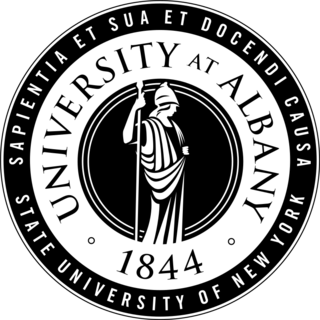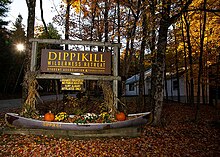
The State University of New York is a system of public colleges and universities in the State of New York. It is one of the largest comprehensive systems of universities, colleges, and community colleges in the United States. Led by chancellor John B. King, the SUNY system has 91,182 employees, including 32,496 faculty members, and some 7,660 degree and certificate programs overall and a $13.37 billion budget. Its flagship universities are SUNY Stony Brook on Long Island in southeastern New York and the SUNY Buffalo in the west.

Stetson University is a private institution located in Central Florida, along the I–4 corridor. Established in 1883 as DeLand Academy, it was later renamed John B. Stetson University in honor of a generous donor. The university's main campus in DeLand spans 175 acres and boasts Florida's oldest collection of education-related buildings, including DeLand Hall, the state's longest-standing building used for higher education.

The State University of New York at Binghamton is a public research university with campuses in Binghamton, Vestal, and Johnson City, New York. It is one of the four university centers in the State University of New York (SUNY) system. As of Fall 2020, 18,128 undergraduate and graduate students attended the university.

The State University of New York at Buffalo, commonly called the University at Buffalo (UB) and sometimes called SUNY Buffalo, is a public research university with campuses in Buffalo and Amherst, New York, United States. The university was founded in 1846 as a private medical college and merged with the State University of New York system in 1962. As of 2022, it is one of two flagship institutions of the SUNY system, along with Stony Brook University. As of fall 2020, the university enrolled 32,347 students in 13 schools and colleges, making it the largest public university in the state of New York.

The State University of New York Buffalo State University is a public university in Buffalo, New York. It is part of the State University of New York (SUNY) system. Buffalo State University was founded in 1871 as the Buffalo Normal School to train teachers. It offers 79 undergraduate majors with 11 honors options, 11 post baccalaureate teacher certification programs, and 64 graduate programs.

The State University of New York at Albany, commonly referred to as the University at Albany, UAlbany or SUNY Albany, is a public research university with campuses in Albany, Rensselaer, and Guilderland, New York. Founded in 1844, it is one of four "university centers" of the State University of New York (SUNY) system.

The State University of New York at New Paltz is a public university in New Paltz, New York. It traces its origins to the New Paltz Classical School, a secondary institution founded in 1828 and reorganized as an academy in 1833.

The State University of New York at Plattsburgh is a public university in Plattsburgh, New York. The university was founded in 1889 and officially opened in 1890. The university is part of the State University of New York (SUNY) system and is accredited by the Middle States Commission on Higher Education. SUNY Plattsburgh has 5,109 students, of whom 4,680 are undergraduates.

The State University of New York at Canton is a public college in Canton, New York. It is part of the State University of New York. The college offers 30 bachelor's degrees, 20 associate degrees, three one-year certificate programs, and 23 online degrees.
Jewish studies is an academic discipline centered on the study of Jews and Judaism. Jewish studies is interdisciplinary and combines aspects of history, Middle Eastern studies, Asian studies, Oriental studies, religious studies, archeology, sociology, languages, political science, area studies, women's studies, and ethnic studies. Jewish studies as a distinct field is mainly present at colleges and universities in North America.

Karen R. Hitchcock was an American biologist and university administrator who had leadership positions at an American and a Canadian university. She served as the President of SUNY's University at Albany in Albany, New York, from 1996 until her resignation in 2003. She was Principal and Vice-Chancellor of Queen's University, in Kingston, Ontario from 2004 until an abrupt resignation in 2008, when she announced her departure in a sudden email to students. After her sudden departure from Queen's University, she returned, with husband Murray Blair, to the Albany, New York, area to live in Vischer Ferry.
Kermit Lance Hall was a noted legal historian and university president. He served from 1994 to 1998 on the Assassination Records Review Board to review and release to the public documents related to the assassination of U.S. President John F. Kennedy.
The Nelson A. Rockefeller College of Public Affairs & Policy is a public policy school composed of the Departments of Public Administration & Policy and Political Science at the University at Albany, SUNY, United States. The department provides educational preparation for academic and public service careers, to undertake research on significant public problems and issues, and to assist in the continuing professional development of government executives. Rockefeller College has an enhanced interdisciplinary approach to its public policy mission.
The College of Nanotechnology, Science, and Engineering is part of the University at Albany, SUNY in Albany, New York. Founded in 2004 at the University at Albany, SUNY, the college underwent rapid expansion in the late-2000s and early-2010s before merging with the SUNY Institute of Technology in 2014. The college rejoined the University at Albany in 2023. The college was the first college in the United States devoted to nanotechnology.

The Undergraduate Student Government (USG) at Stony Brook University is a governing body representing the undergraduate students of Stony Brook University. As with most student governments in the United States, one of USG's main functions is to recognize, fund and regulate student organizations. The USG is composed of an executive, a legislative, and a judicial branch. Along with the Graduate Student Organization, USG is the only other organization authorized to distribute the Student Activity Fee (SAF) in a viewpoint-neutral manner. In accordance with State University of New York Policies and Procedures, the mandatory SAF provides the USG with an annual budget of approximately $3.1 million, independently of the state budget.

The George Washington University Student Government Association is the student government of the George Washington University in Washington, DC. The SGA is responsible for advocacy on behalf of the GW student body at and is modeled after the U.S. Federal Government and consists of three branches: legislative, executive and judicial.

The University of Texas at Rio Grande Valley (UTRGV) is a public research university with multiple campuses throughout the Rio Grande Valley region of Texas. It is the southernmost member of the University of Texas System. The University of Texas at Rio Grande Valley was created by the Texas Legislature in 2013 after the consolidation of the University of Texas at Brownsville/Texas Southmost College and the University of Texas–Pan American.

The State University of New York Polytechnic Institute is a public university in Marcy, New York. It is part of the State University of New York (SUNY) system. Established in 1966 using classrooms at a primary school, what became SUNY Poly is New York's public polytechnic college. The college, formerly the SUNY Institute of Technology, has a Utica, New York mailing address and was established in 1987.

Robert J. Jones is an American crop physiology scientist who is the tenth chancellor of the University of Illinois Urbana-Champaign. Jones is the first African-American to hold this office. He previously served as president of the University of Albany. In addition to his academic career, Jones was a tenor singer in Sounds of Blackness, a vocal ensemble from Minneapolis/St. Paul, Minnesota that sings gospel, soul, and R&B.
Jeffrey Berman is a literary scholar, author, and editor. He is a Distinguished Teaching Professor of English at the University at Albany, SUNY, He is the author or co-author of over twenty books and one hundred and fifty articles, book chapters, and reviews, including Dying to Teach: A Memoir of Love, Loss, and Learning, and Cutting and the Pedagogy of Self-Disclosure. His research interests include literature and psychoanalysis, trauma theory, love and loss, death education, and self-disclosure pedagogy.
















